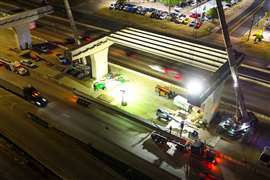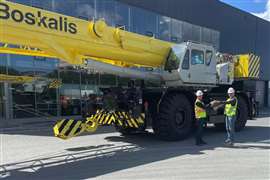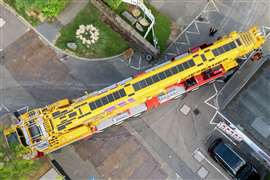Drilling down: Oil & gas sector heats up in U.S.
27 August 2013

Economists and investors seem to be gushing about the prospects for American oil and gas production. Late last year, the International Energy Agency (IEA) forecast that the United States will pass Saudi Arabia as the world’s leading oil producer within a decade. In IEA’s central scenario, the U.S. becomes a net exporter of natural gas by 2020 and North America emerges as a net oil exporter by 2035.
Supporting IEA’s prediction was new data released on April 30 by the United States Geological Survey (USGS), which indicated that 7.4 billion barrels of oil could be recovered from two massive shale formations spanning parts of North Dakota, South Dakota and Montana. That nearly doubles previous USGS estimates. In addition to oil, the two formations contain an estimated 6.7 trillion cubic feet of undiscovered, technically recoverable natural gas and 0.53 billion barrels of undiscovered, technically recoverable natural gas liquids.
Conoco recently announced that over half of its nearly $15 billion budget for this year would be spent in North America. The company’s oil and gas production rose a combined 42 percent in North Dakota’s Bakken shale and Texas’ Permian Basin and Eagle Ford shale. Meanwhile, Exxon’s U.S. oil and natural gas production increased 2 percent in the first quarter, compared with a worldwide output decline of 3.5 percent.
This all comes atop a U.S. natural gas production jump of one-third from 2005 to 2012. Last year, natural gas production reached an all-time high of 25.3 trillion cubic feet, according to the U.S. Energy Information Administration.
Plenty of signs indicate this increased oil and natural gas production already is reenergizing the specialized transport and rigging industry. Much of the attention has turned to fracking, the industry nickname for a process officially known as hydraulic fracturing, which involves blasting millions of gallons of water, sand and chemicals into substrate rock. The intense pressure creates fractures in the rock layer and allows easier access to the oil and gas beneath.
Fracking bonanza
New horizontal and directional fracking processes have given oil and natural gas producers the ability to drill lengthwise through shale deposits and tap previously inaccessible sources of oil and natural gas. Reaching and extracting these resources from the ground requires rugged equipment. Moreover, the companies supplying this equipment face additional challenges because the fields typically lie beneath rough terrains and remote locations. In response, equipment manufacturers and users are changing as rapidly as the nature of the work.
For example, at the Marcellus Shale natural gas fields in Pennsylvania, National Crane boom trucks insert wire-line cabling and related tools into several natural gas and oil well sites. In the past, mast trucks handled a majority of work in such fields, but that forced operators to move these vehicle for every lift, tediously rigging and un-rigging the winch mechanisms each time. Now, crane operators can rig a boom truck for several lifts from the same spot, saving time and money.
“We need all the cranes we use on the gas and oil field to have at least 125 feet of main boom so that we can place tools into multiple wells without having to move the truck,” says Rodney Offield, manager of the Pittsburgh, PA branch of Renegade Wireline Services. “The cranes also have to have a high load rating at the boom tip to handle the intense weight of the multi-ton rigging and cable-hoisting operations.”
Offield says that in the oil and gas business, jobs come suddenly and his company must react immediately. Renegade doesn’t have to worry about obtaining last-minute highway permits because the boom trucks are mounted on commercial chassis that comply with federal bridge laws.
“Bigger cranes are subject to federal size and weight laws in Pennsylvania,” he says. “If we used truck cranes that had similar capabilities to these boom trucks or bigger cranes, we’d have to have a person in-office filing permits each time we wanted to cross state lines or drive over a bridge.”
When Navistar International Corp. reintroduced its PayStar 5900 Set-Back Axle (SBA) severe-service model at ExpoCam, Canada’s National Trade Show, in April, the company made a point of emphasizing that the model, now featuring the Cummins ISX15 engine with selective catalytic reduction (SCR) technology, was a very good fit for Canada’s oil fields.
The engine offers robust electronic controls and 400 to 600 horsepower ratings with 1,450-2,050 pound-feet of torque for excellent power and performance, and the frame-rail options and aluminum cab deliver unsurpassed strength and maneuverability, according to Navistar. The PayStar 5900 SBA, available as either a truck or tractor, can handle gross weights of up to 150,000 pounds. A sloped hood enhances visibility through a one-or two-piece windshield.
“Canada can be tough on a vehicle, and the power of the ISX15 makes our already rugged vehicles adaptable for any environment,” says Mark Belisle, Navistar Canada president.
Focused on energy
Another company that takes considerable pride in offering equipment designed to meet the demanding conditions of oil and natural gas fields is Talbert Manufacturing.
“First and foremost, our company has earned a reputation for the ruggedness and durability of its trailers over the past 75 years,” says Greg Smith, vice president of sales and manufacturing at Talbert. “Over 90 percent of Talbert trailers built since 1985 are still in operation today. That same durability makes our trailers well suited for oil fields.”
Talbert’s series of three-, four- and five-axle lowbed, gooseneck trailers initially were built to the specifications of the company’s dealer in Corpus Christi, TX. The popular 60 FG Oil Field Lowbed is 56 feet, 3 inches long, 8 feet, 6 inches wide and 40 inches high. It weighs 27,600 pounds and has a capacity of 120,000 pounds (with 110,000 pounds capacity in any 16-foot load base). Smith points out that Talbert designs to the highest possible safety factor at any capacity.
“We don’t sell those trailers to any other segment than the oil and gas industry,” he says. “Not only do they have to stand up to off-road conditions, but they also need to be able to handle continuous operation from site preparation through final clean-up.”
He notes that another important consideration is the nature of the loads.
“These users work with a lot of compressors, generators, fracking tanks and other items on a self-contained base that need to be picked up and moved from place to place,” he says. “They can use a powerful winch to lift those skids over the trailer roller and then drag them into place, using the trailer’s guide posts to help keep the load where it needs to be. It takes a special type of trailer to handle all of that.”
Smith says the oil-field series has opened up his company to new avenues of customers it had not been able to service through its network of 80 dealers. Moreover, he sees the positive response to the oil-field trailers as a way to interest dealers in other Talbert trailers for other markets, a situation that already has occurred at a dealership in Canada.
Talbert acknowledges that, after “going at a white-hot pace,” the market has performed a little below projections lately.
“We believe there is a lot of opportunity out there as the nation moves toward energy self-sufficiency, but we also think taking a more measured approach is a good thing,” he says.
Tyler Henley, sales manager of Horizon Cable Service’s office in Oklahoma City, agrees that caution is necessary in such an unpredictable market segment.
“We always remember we’re involved with a volatile industry, but we have to stay optimistic about the future,” he says. “We’ve seen steady growth in the oil and natural gas business, and there are no signs of that business slowing down. April is typically one of our worst months, but we had a record month this April companywide.”
He attributes much of his company’s recent growth to installation and maintenance of cable on well-servicing rigs with a custom-built fleet of 12 mobile spooling units, each mounted with a crane. The units also are used to install large-diameter cable on cranes used for oil and gas production, as well as other applications such as wind farms.
“Much of the growth is related to the increase in horizontal drilling and hydraulic fracturing,” says Henley. “There’s a lot of wear and tear on the cable in these horizontal wells, and we’ll go in and tighten it up, oil it, and do whatever else it takes to keep customers up and running safely day and night.”
And there’s a lot of cable, too. A single truck may hold 30,000 feet of electrically-charged wireline used to energize a variety of tools at the end of the line.
The company’s search for new opportunities has led owner, Bruce Miller to expand to seven locations, including new offices in Hobbs, NM and, before that, Williston, ND.
“Our location in North Dakota was an instant success,” Henley says.
Horizon Cable’s experience typifies the way a variety of specialized carrier and rigging companies are fueling success through quality service to the oil and natural gas companies.
STAY CONNECTED


Receive the information you need when you need it through our world-leading magazines, newsletters and daily briefings.
CONNECT WITH THE TEAM











